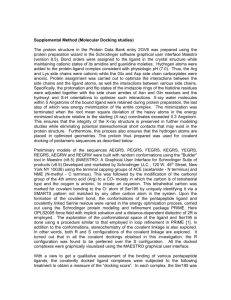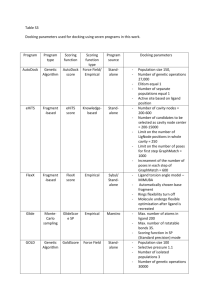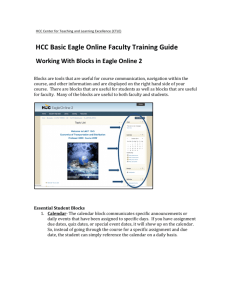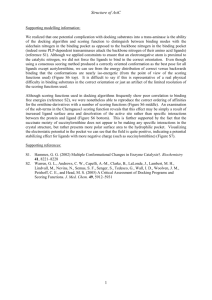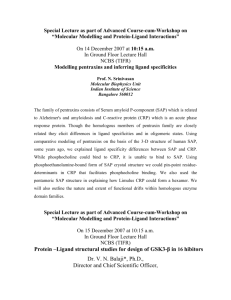Document 13309459
advertisement
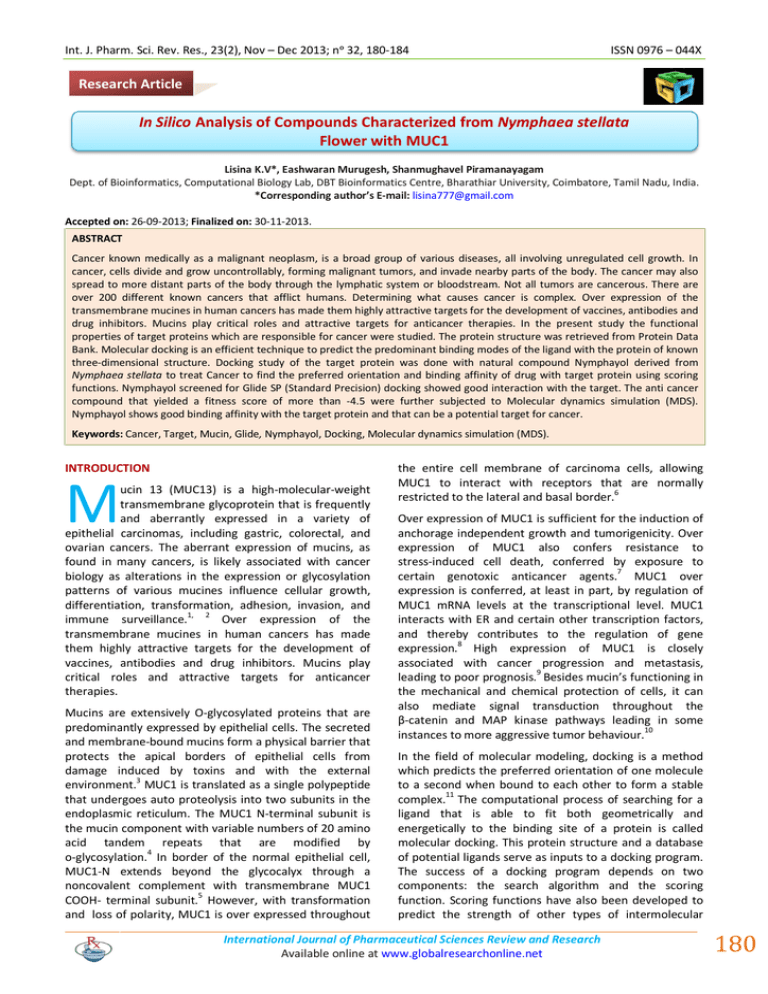
Int. J. Pharm. Sci. Rev. Res., 23(2), Nov – Dec 2013; nᵒ 32, 180-184 ISSN 0976 – 044X Research Article In Silico Analysis of Compounds Characterized from Nymphaea stellata Flower with MUC1 Lisina K.V*, Eashwaran Murugesh, Shanmughavel Piramanayagam Dept. of Bioinformatics, Computational Biology Lab, DBT Bioinformatics Centre, Bharathiar University, Coimbatore, Tamil Nadu, India. *Corresponding author’s E-mail: lisina777@gmail.com Accepted on: 26-09-2013; Finalized on: 30-11-2013. ABSTRACT Cancer known medically as a malignant neoplasm, is a broad group of various diseases, all involving unregulated cell growth. In cancer, cells divide and grow uncontrollably, forming malignant tumors, and invade nearby parts of the body. The cancer may also spread to more distant parts of the body through the lymphatic system or bloodstream. Not all tumors are cancerous. There are over 200 different known cancers that afflict humans. Determining what causes cancer is complex. Over expression of the transmembrane mucines in human cancers has made them highly attractive targets for the development of vaccines, antibodies and drug inhibitors. Mucins play critical roles and attractive targets for anticancer therapies. In the present study the functional properties of target proteins which are responsible for cancer were studied. The protein structure was retrieved from Protein Data Bank. Molecular docking is an efficient technique to predict the predominant binding modes of the ligand with the protein of known three-dimensional structure. Docking study of the target protein was done with natural compound Nymphayol derived from Nymphaea stellata to treat Cancer to find the preferred orientation and binding affinity of drug with target protein using scoring functions. Nymphayol screened for Glide SP (Standard Precision) docking showed good interaction with the target. The anti cancer compound that yielded a fitness score of more than -4.5 were further subjected to Molecular dynamics simulation (MDS). Nymphayol shows good binding affinity with the target protein and that can be a potential target for cancer. Keywords: Cancer, Target, Mucin, Glide, Nymphayol, Docking, Molecular dynamics simulation (MDS). INTRODUCTION M ucin 13 (MUC13) is a high-molecular-weight transmembrane glycoprotein that is frequently and aberrantly expressed in a variety of epithelial carcinomas, including gastric, colorectal, and ovarian cancers. The aberrant expression of mucins, as found in many cancers, is likely associated with cancer biology as alterations in the expression or glycosylation patterns of various mucines influence cellular growth, differentiation, transformation, adhesion, invasion, and immune surveillance.1, 2 Over expression of the transmembrane mucines in human cancers has made them highly attractive targets for the development of vaccines, antibodies and drug inhibitors. Mucins play critical roles and attractive targets for anticancer therapies. Mucins are extensively O‐glycosylated proteins that are predominantly expressed by epithelial cells. The secreted and membrane‐bound mucins form a physical barrier that protects the apical borders of epithelial cells from damage induced by toxins and with the external environment.3 MUC1 is translated as a single polypeptide that undergoes auto proteolysis into two subunits in the endoplasmic reticulum. The MUC1 N‐terminal subunit is the mucin component with variable numbers of 20 amino acid tandem repeats that are modified by 4 o‐glycosylation. In border of the normal epithelial cell, MUC1‐N extends beyond the glycocalyx through a noncovalent complement with transmembrane MUC1 COOH‐ terminal subunit.5 However, with transformation and loss of polarity, MUC1 is over expressed throughout the entire cell membrane of carcinoma cells, allowing MUC1 to interact with receptors that are normally restricted to the lateral and basal border.6 Over expression of MUC1 is sufficient for the induction of anchorage independent growth and tumorigenicity. Over expression of MUC1 also confers resistance to stress‐induced cell death, conferred by exposure to certain genotoxic anticancer agents.7 MUC1 over expression is conferred, at least in part, by regulation of MUC1 mRNA levels at the transcriptional level. MUC1 interacts with ER and certain other transcription factors, and thereby contributes to the regulation of gene expression.8 High expression of MUC1 is closely associated with cancer progression and metastasis, leading to poor prognosis.9 Besides mucin’s functioning in the mechanical and chemical protection of cells, it can also mediate signal transduction throughout the β‐catenin and MAP kinase pathways leading in some instances to more aggressive tumor behaviour.10 In the field of molecular modeling, docking is a method which predicts the preferred orientation of one molecule to a second when bound to each other to form a stable 11 complex. The computational process of searching for a ligand that is able to fit both geometrically and energetically to the binding site of a protein is called molecular docking. This protein structure and a database of potential ligands serve as inputs to a docking program. The success of a docking program depends on two components: the search algorithm and the scoring function. Scoring functions have also been developed to predict the strength of other types of intermolecular International Journal of Pharmaceutical Sciences Review and Research Available online at www.globalresearchonline.net 180 Int. J. Pharm. Sci. Rev. Res., 23(2), Nov – Dec 2013; nᵒ 32, 180-184 12 interactions, for example between two proteins or between protein and DNA.13 Novel ligands for enzymes of known structure were designed and their interaction 14 energies were calculated using the scoring function. Secondary chemicals are important in plant use by humans. Most pharmaceuticals are based on plant chemical structures, and secondary metabolites are widely used for recreation and stimulation. Secondary metabolites are derived from Primary metabolites. Alkaloids, Terpenoids and Phenolics are main secondary metabolites. The plant chemicals used for these latter purposes are largely the secondary metabolites, which are derived biosynthetically from plant primary metabolites (e.g., carbohydrates, amino acids, and lipids) and are not directly involved in the growth, development, or reproduction of plants. These secondary metabolites can be classified into several groups according to their chemical classes, such alkaloids, terpenoids, and phenolics.15 Throughout human civilization the plant world has provided a rich source of medicinal and recreational drugs. In the past 100 years many of the active compounds in these folk remedies have been purified, identified, studied and, in some cases, synthesized to provide effective treatments. Plants have been used by man since the beginning of human culture for a great variety of purposes, including medicine. Plants have provided nearly half of the world’s successful drugs, ranging from anticancer drugs from the tiny periwinkle plant, to painkillers from willow bark, and even contraceptives from yams! Plants have provided modern medicine with more diverse and important drugs than any other natural source. 16 MATERIALS AND METHODS Compounds identified from Nymphaea stellata Nymphayol [17-(hexan-2-yl)-10, 13-dimethylhexa decahydro-lH cyclopenta[a]phenanthren -3-ol], a novel crystal was isolated from chloroform extract of Nymphaea stellata Willd. Flower of N. stellata contain a lead compound Nymphayol (25, 26- dinorcholest-5-en3β–ol). The structure was determined on the basis of Xray crystallography and spectral data. The flowers of plant contain flavonoids, gallic acid, astrgalin, quercetin, and kaempferol. Recently, Nymphaea stellata flowers have been reported to have hepatoprotective activity against CCl4-induced hepatic damage. This review is an attempt to provide the pharmaceutical prospectus of Nymphaea stellata. 17 ISSN 0976 – 044X generally unassigned. Glide calculations use an all-atom force field for energy evaluation. The target proteins were prepared for Glide Docking calculations using the Protein Preparation Wizard. The ligand and water molecules and residues were removed from the protein and H atoms were added to the structure; and the chemistry of the protein was corrected for missing hydrogen. Following the above steps of preparation, the protein was subjected to energy minimization using the options from Schrodinger. Ligand preparation The three dimensional structure of compounds taken for binding analysis were downloaded in .sdf format from PubChem database. Generate low energy conformations. Lipinski properties such as Molecular weight, XLog P, number of hydrogen bond donors and acceptors for the compounds were obtained from PubChem (shown in Table: 1). These structures were used for docking and pharmacokinetic studies. Output file created after LigPrep was ligandout.maegz Table 1: Physiochemical Properties of Compounds Identified in Nymphaea stellata. Compound name Mol. wt Xlogp H-Bond donor H-Bond acceptor Nymphayol 358.60038 7.9 1 1 Here ligand Nymphayol is taken for binding affinity studies. The validation process consisted of two parts; • Hydrogen bond details of the top-ranked docked pose. • Prediction of binding energy between the docked ligand and the enzyme using various scores calculated using Schrodinger. Active site Prediction The active site is the site in which the interactions between the protein and ligand molecules occur. The active sites for the target proteins (MUC1) were predicted using Sitemap of Schrödinger. Protein preparation The PDB is a key resource in areas of structural biology, is a key repository for 3D structure data of large molecules. The molecule which taken is MUC1 for our consideration. The PDB ID is 2ACM. The quality of Glide results depends on reasonable starting structures for both the protein and the ligand. The PDB structure generally has no information on bond orders, topologies, or formal atomic charges. Ionization and tautomeric states are also Figure 1: Predicted Active site of MUC1 using Sitemap International Journal of Pharmaceutical Sciences Review and Research Available online at www.globalresearchonline.net 181 Int. J. Pharm. Sci. Rev. Res., 23(2), Nov – Dec 2013; nᵒ 32, 180-184 Receptor Grid Generation The outputs from sitemap prediction were given as the input for Receptor Grid generation. Grid box generated for about 50 Angstrom within the DNA binding site of the protein (MUC1). The out file generated was 1.zip which was given as an input for Protein- ligand docking. Docking studies Ligand Docking Output files generated from receptor grid generation (1.zip) and LigPrep (ligandout.mae) were loaded in the ligand docking panel. Output file generated after ligand docking was lig1.pv.maegz. Docking method used in this study is Glide. Glide is a ligand docking program for predicting protein-ligand binding modes and ranking ligands via high-throughput virtual screening. Glide utilizes two different scoring functions, SP and XP Glide Score, to rank-order compounds. Three modes of sampling ligand conformational and positional degrees of freedom are available to determine the optimal ligand orientation relative to rigid protein receptor geometry. The effects of ligand number, docking order and drug likeness of ligands and closeness of the binding site were investigated. On average 36% of all structures were reproduced with RMSDs lower than 2 Å. Correctly docked structures reached 50% when docking drug like ligands into closed binding sites by the SP hard protocol. Each ligand compound is given as input in the parameter meant for “input ligands” and the protocol was run for the inhibitors selected for the study. The Dockscore of the best poses docked into the enzyme for the selected chemical compound is calculated. Molecular dynamics simulations ISSN 0976 – 044X docking analysis with the protein Mucins (MUCI). Docked pose of the compound with protein (Mucin) is presented in Figure 2. The ligand Nymphayol docked with protein Mucin with -7.072291 dock score value. The active site of the target protein determined using site map prediction. Docking done using Glide and the Receptor and ligand can browse for prepared output files. Molecular docking is an efficient technique to predict the predominant binding modes of the ligand with the protein of known three-dimensional structure. Studies on binding modes are essential to elucidate key structural characteristics and interactions and they provide helpful data for designing effective inhibitors. Glide score -7.072291 Glide energy -46.388051 Figure 2: Docking pose of Nymphayol with Mucin Molecular dynamics can be used to explain protein structure function problems, such as folding, conformational flexibility and structural stability. In the simulations, we monitored the backbone atoms and the C-α-helix of the modelled protein. The RMSD values of the modelled structure’s backbone atoms were plotted as a time-dependent function of the MD simulation. The results support our modelled structure, as they show constant RMSD deviation throughout the whole simulation process. Graphs of potential energy, temperature, pressure and volume and time dependence of the RMSD (Å) of the backbone atoms of the modelled protein during a 5 ns simulation is shown in Fig. 4. The RMSD values of the backbone atoms in the system tend to converge after 2000 ps, showing fluctuations of around 1 Å. The low RMSD and the simulation time indicate that, as expected, the 3D structural model of 2ACM represents a stable folding conformation. Figure 3: Interatomic distances between H-bonded atoms are indicated in yellow. All distances are in Angstrom RESULTS AND DISCUSSION The structure of Mucin with PDB ID 2ACM is retrieved from PDB. The resolution factor is retrieved from PDB. The structure of 2ACM has in total 2 chains viz. A, B. The chemical compound Nymphayol taken as a ligand for International Journal of Pharmaceutical Sciences Review and Research Available online at www.globalresearchonline.net 182 Int. J. Pharm. Sci. Rev. Res., 23(2), Nov – Dec 2013; nᵒ 32, 180-184 Molecular dynamics results ISSN 0976 – 044X REFERENCES 1. Raina D, Ahmad R, Joshi MD, Yin L, Wu Z, Kawano T, Vasir B, Avigan D, Kharbanda S, Kufe D, Direct targeting of the mucin 1 oncoprotein blocks survival and tumorigenicity of human breast carcinoma cells, Cancer Res., 69(12), 2009, 5133‐41. 2. Agata N, Ahmad R, Kawano T, Raina D, Kharbanda S, Kufe D, MUC1 oncoprotein blocks death receptor‐mediated apoptosis by inhibiting recruitment of caspase‐8, Cancer Res., 68(15), 2008, 6136‐44. 3. Ramasamy S, Duraisamy S, Barbashov S, Kawano T, Kharbanda S, Kufe D, The MUC1 and galectin‐3 oncoproteins function in a microRNA‐dependent regulatory loop, Mol Cell., 27(6), 2007, 992‐1004. 4. Ren J, Raina D, Chen W, Li G, Huang L, Kufe D, MUC1 oncoprotein functions in activation of fibroblast growth factor receptor signaling, Mol Cancer Res., 4(11), 2006, 873‐83. 5. MacDermed DM, Khodarev NN, Pitroda SP, Edwards DC, Pelizzari CA, Huang L, Kufe DW, Weichselbaum RR, MUC1‐associated proliferation signature predicts outcomes in lung adenocarcinoma patients, BMC Med Genomics, 3, 2010, 1‐12. 6. Pitroda SP, Khodarev NN, Beckett MA, Kufe DW, Weichselbaum RR, MUC1‐induced alterations in lipid metabolic gene network predict response of human breast cancers to tamoxifen treatment, Proc Natl Acad Sci., 106(14), 2009, 5837‐41. 7. Mikami Y, Hisatsune A, Tashiro T, Isohama Y, Katsuki H, Hypoxia enhances MUC1 expression in a lung adenocarcinoma cell line, Biochem Biophys Res Commun., 379(4), 2009, 1060‐5. 8. Abrosimov AY, Shkurko OA, Saenko VA, Meirmanov S, Rogounovitch TI, Lushnikov EF, Nakashima M, Namba H, Mitsutake N, Yamashita S, Immunoexpression of MUC1 in papillary thyroid carcinoma: An association with aberrant expression of B‐catenin and cyclin D1 over expression, International congress series, 1299, 2007, 263‐270. 9. Hollingsworth MA, Swanson BJ, Mucins in cancer: protection and control of the cell surface, Nat Rev Cancer, 4 (1), 2004, 45–60. 10. Dong Y, Walsh MD, Cummings MC, Wright RG, Khoo SK, Parsons PG, McGuckin MA, Expression of MUC1 and MUC2 mucins in epithelial ovarian tumours, J Pathol., 183(3), 1997, 311–7. 11. Lengauer T, Rarey M, Computational methods for bimolecular docking, Curr.Opin.Struct. Biol., 6 (3), 1996, 402–6. 12. Lensink MF, Méndez R, Wodak SJ, Docking and scoring protein complexes: CAPRI 3rd Edition, Proteins., 69 (4), 2007, 704-18. 13. Robertson TA, Varani G, An all-atom, distance-dependent scoring function for the prediction of protein-DNA interactions from structure, Proteins., 66 (2), 2007, 359– 74. 14. Irwin JJ, Lorbes DM, Mchovern SL, Wei B and Shoichet BK, Computational nano-science and nanotechnology, 2002, ISBNO- 9708275-6-3. Figure 4: RMSD of the backbone atoms of the modelled protein over a time period of 1 picoseconds CONCLUSION It is important to understand the role of chemical compounds i.e. Nymphayol from Nymphaea stellata. Chemical compounds bind to specific receptors on target protein. In silico molecular docking is one of the most powerful techniques to discover novel ligand for proteins of known structure and thus play a key role in structure based drug designing. Investigators often use docking computer programs to find the binding affinity for molecules that fit a binding site on the protein. Hence in this present work we have carried out in silico molecular docking to analyze the binding properties of the mediator called Mucin with Nymphayol, the chemical compounds reported from the flower of Nymphaea stellata. The target protein Mucin was validated by molecular dynamics simulation. So the present study may act as supportive evidence that substantiates property of this plant flower extract may be a good drug because of the inhibiting ability of Nymphayol identified from this plant flower with MUC1. International Journal of Pharmaceutical Sciences Review and Research Available online at www.globalresearchonline.net 183 Int. J. Pharm. Sci. Rev. Res., 23(2), Nov – Dec 2013; nᵒ 32, 180-184 15. Harborne JB, Phytochemical Methods: A Guide to Modern Techniques of Plant Analysis, 2nd edn. Chapman and Hall, New York, 1984. 16. Farnsworth NR and Morris RW, Higher plants: the sleeping giant of drug development, Am. J. Pharm Sci Support Public Health, 148 (2), 1976, 46-52. 17. ISSN 0976 – 044X Das Doli Rani, Sachan Anupam Kumar, Mohd. Shuai, Gangwar Sudhir S, Nymphaea Stellata: A Potential herb and its medicinal importance, Journal of Drug Delivery & Therapeutics, 2(3), 2012, 41-44. Source of Support: Nil, Conflict of Interest: None. Corresponding Author’s Biography: Ms. Lisina.K.V Ms. Lisina graduated from Pondicherry University, post graduated at Bharathiar University, Coimbatore and finished her Master of Philosophy at Karpagam University, Coimbatore. At post graduation level taken specialization in Bioinformatics, completed master thesis in “A Study on Marine Compounds as Anti Inflammatory Agents”. She has finished her Master of Philosophy thesis in “A Comparative Study of Justicia Adhatoda, Mimosa Pudica and Vitex Negundo against Hepatoprotective Activity in Albino Rats - In Vitro and In Vivo Evaluation”. Currently as a Research Scholar at the department of Bioinformatics, Bharathiar University. International Journal of Pharmaceutical Sciences Review and Research Available online at www.globalresearchonline.net 184
